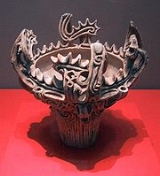
National treasures of Japan
Overview
Tangible Cultural Properties of Japan
as defined by the Japanese government's Law for the Protection of Cultural Properties are Cultural PropertiesIn this article, capitals indicate an official designation as opposed to a simple definition, e.g "Cultural Properties" as opposed to "cultural properties"...
, as determined and designated by the Agency for Cultural Affairs
Agency for Cultural Affairs
The is a special body of the Japanese Ministry of Education . It was set up in 1968 to promote Japanese arts and culture. As of April 2007, it is led by the Commissioner for Cultural Affairs, Tamotsu Aoki....
(a subsidiary of the Ministry of Education, Culture, Sports, Science and Technology
Ministry of Education, Culture, Sports, Science and Technology (Japan)
The , also known as MEXT or Monkashō, is one of the ministries of the Japanese government.The Meiji government created the first Ministry of Education in 1871....
). A Tangible Cultural Property is considered to be of historic or artistic value, classified either as "buildings and structures", or as "fine arts and crafts". Each National Treasure must show outstanding workmanship, a high value for world cultural history, or exceptional value for scholarship.
Approximately 20% of the National Treasures are structures such as castles
Japanese castle
' were fortresses composed primarily of wood and stone. They evolved from the wooden stockades of earlier centuries, and came into their best-known form in the 16th century...
, Buddhist temples
Buddhist temples in Japan
Along with Shinto shrines, Buddhist temples are the most numerous, famous, and important religious buildings in Japan.The term "Shinto shrine" is used in opposition to "Buddhist temple" to mirror in English the distinction made in Japanese between Shinto and Buddhist religious structures. In...
, Shinto shrines, or residences.

